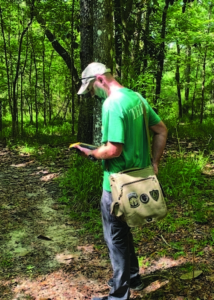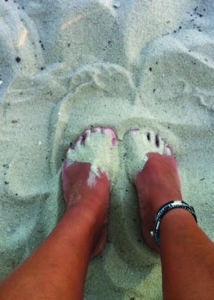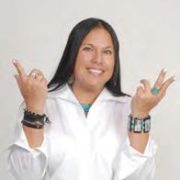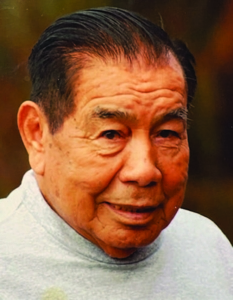chickee talk Climate Change and the Land of My Ancestors

Seminole Tribe’s Archaeologist & Crew Chief, Shawn Keyte, June 2022, inspecting a site in North Florida for cultural resource evidence.
As we close out the Summer of 2022, most of you will probably agree, it seems to get intolerably more hot with each passing year. I tried walking on the beach to get some steps in and found the sand to be equal to walking on asphalt. Now, it may be my age, but as a person who grew up on the beach and spent a great deal of my time enjoying the sun and fun of living in paradise, I never remember the sand burning my feet. I realize that discussing climate change is a touchy subject because many deny its existence and the mere mention of it can provoke violence. That is not my intent. I want to tell you about climate change and my Tribe… mostly about the land of my ancestors.
As a Seminole, I am asked quite regularly, “Where do y’all come from?” Could you hear my Southern accent? Just kidding, but the question is what some call “loaded” because depending on who you ask, the answers will vary. In some cases, like my own, my answer has varied depending on which chapter of my life the question was posed. As a young child, I would reply that we are from Florida. My answer was solely based that I knew I was Seminole and that I lived in Florida, so Seminoles must be from Florida.
As I grew older and reached middle school, I had begun reading books about my own people and was listening to the academic scholars of the day, who said that we were a tribe of runaways. We were all originally from Georgia and Alabama and were all forced into Florida because of the Civil War, and the “Indian Wars.” To me, that was shocking because I felt disconnected from my own sense of home.
Of course, I have always been very inquisitive. I want to know and understand the big picture. I was not satisfied with that story… it did not feel “right” to me. I would eavesdrop on conversations, and I remember hearing my dad’s older brother, Uncle Pete, talk about the Calusa. He would let me ask questions because I think my interest intrigued him. As an adult, my questions probably annoyed him, but as a young person, he was generous with his time. He told me not to believe the stories that we aren’t from here. That you can’t believe what they write in books because the “experts” don’t know. Our ancestors lived here and survived. Uncle Pete didn’t go deep into explaining this to me. I always felt that he owed me no explanation, he was there just to give me the facts.
In my professional life with the Seminole Tribe of Florida, this question still comes up and it’s fairly common. Remember, the question of where an “Indian” is from can be loaded? This is why… We are not a race of people. We are legally defined as a political entity given that we are members of a federally recognized Tribe. All three branches of government still struggle with the “Indian problem.” If you want to weaken a Tribe, how best to do that? You disconnect them from their homelands. You alienate, isolate them from their traditional plants, sacred sites, and natural resources. Every day when I go to work, it is a face off with a federal agency, public institution or private citizen who tries to use academic scholarship to sever the bond between our people and our ancestral lands.
 How does this tie back to my burnt, red feet from this summer? It’s easy. The Tribal Historic Preservation Office (THPO) for the Seminole Tribe of Florida has developed a map that illustrates the expanse of our ancestral lands. It is our duty to figure out a way to protect the cultural resources within this area. We need to make sure we do everything we can to protect our traditional plants, historic sites, and burial resources. We also have to plan for our communities.
How does this tie back to my burnt, red feet from this summer? It’s easy. The Tribal Historic Preservation Office (THPO) for the Seminole Tribe of Florida has developed a map that illustrates the expanse of our ancestral lands. It is our duty to figure out a way to protect the cultural resources within this area. We need to make sure we do everything we can to protect our traditional plants, historic sites, and burial resources. We also have to plan for our communities.
Once our resources are compromised by rising sea levels and excessive heat, we may have to look to move our people back to some of these areas. This year, I am going to focus on sharing some of these stories with you and take you on a journey to show you where my people come from. See you in the next issue!





Leave a Reply
Want to join the discussion?Feel free to contribute!